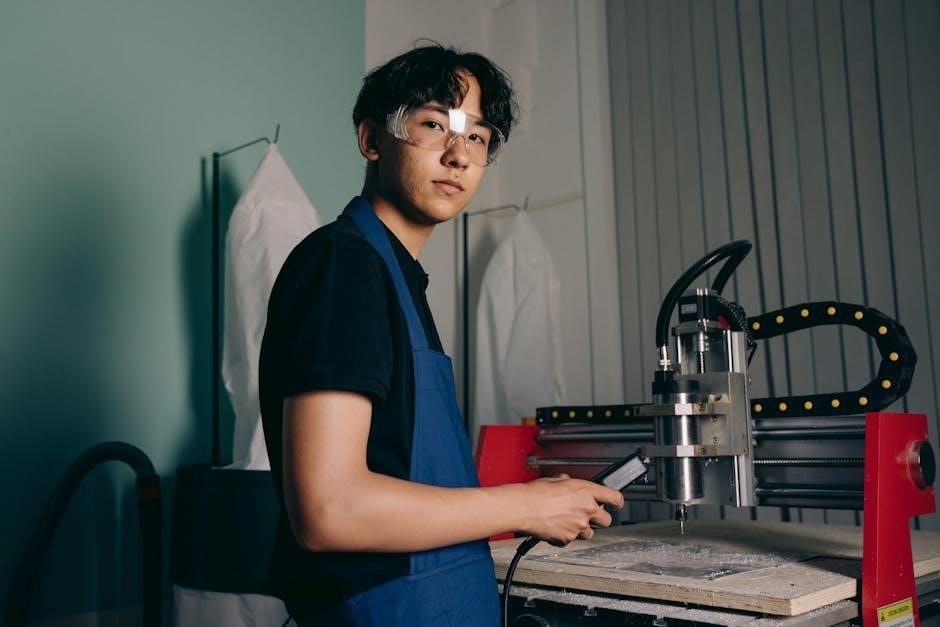Renishaw probe programming enables precise measurement and inspection in manufacturing. This guide provides essential insights into setting up, calibrating, and optimizing Renishaw probes for accurate results.
1.1 Overview of Renishaw Probe Systems
Renishaw probe systems are advanced measurement solutions designed for precision and efficiency in manufacturing. They include a range of probes, such as optical and tactile systems, compatible with CNC machines and industrial applications. These systems enhance measurement accuracy and streamline production processes. The REVO-2, for example, is a dynamic measuring head that maximizes throughput while maintaining precision. Understanding these systems is crucial for optimizing their use in various industrial settings, ensuring reliable and high-quality results.
1.2 Importance of Probe Calibration and Programming
Probe calibration and programming are critical for ensuring accurate and reliable measurements in manufacturing. Proper calibration eliminates measurement errors, while programming enables seamless integration with machine tools. Without calibration, probes may provide inconsistent results, leading to production delays and quality issues. Regular programming updates also enhance system functionality and efficiency, ensuring optimal performance in industrial applications. Understanding these processes is vital for maintaining precision and consistency in measurement tasks, ultimately supporting overall manufacturing success and product quality.

System Requirements and Compatibility
Renishaw probe systems require specific hardware and software compatibility for optimal performance. Ensure your machine tools and CNC controllers meet the specified requirements for seamless integration.
2.1 Hardware Compatibility with Renishaw Probes
Hardware compatibility is crucial for Renishaw probe systems to function effectively. Ensure your CNC machine tools and controllers support Renishaw’s probe interfaces. The REVO-2 and MP700 systems are designed for integration with various machine tools, including Haas VF series. Compatibility with specific controllers and mounts, such as Renishaw part no. H-2000-6221, is essential for accurate measurements. Always verify hardware specifications to ensure seamless operation and optimal performance.
2.2 Software Requirements for Probe Programming
Software compatibility is vital for effective Renishaw probe programming. Ensure your system runs the latest versions of Renishaw’s software packages, designed for seamless integration with CNC controllers. Refer to the programming manual for detailed specifications. The Probe Setup app simplifies installation with interactive guidance. Always verify software compatibility to maintain optimal performance and ensure accurate measurements. Updated software ensures enhanced functionality and compatibility with Renishaw’s probe systems.

Probe Setup and Installation
Install and configure Renishaw probes using the Probe Setup app for clear guidance. Refer to installation manuals for specific machine tools, ensuring proper integration and optimal performance.
3.1 Initial Setup and Configuration
Begin by reviewing the Renishaw probe manual to understand system requirements. Connect the probe to your machine tool and install necessary drivers. Launch the probe software and follow on-screen instructions for initial setup. Ensure all components are recognized by the system. Configure communication settings to match your CNC controller specifications. Proper initial setup guarantees smooth operation and accurate measurements. Refer to the manual for detailed step-by-step guidance.
3.2 Installing Probe Software and Drivers
Download the latest software and drivers from Renishaw’s official website. Run the installation package and follow the prompts to install the probe software. Ensure all drivers are updated to the newest versions for optimal compatibility. Restart your system after installation to apply changes. Verify that the software recognizes the probe hardware. Consult the manual for troubleshooting if issues arise during installation. Proper software setup is crucial for seamless probe functionality and accurate measurements.
3.3 Physical Installation of the Probe System
Mount the probe system securely on the machine tool, ensuring proper alignment and clearance. Connect all cables to the appropriate ports on the CNC controller. Tighten all connections firmly to prevent loosening during operation. Refer to the manual for specific torque values and mounting configurations. Double-check the probe’s orientation and alignment with the machine’s coordinate system. Ensure all components are properly seated and secured to avoid vibration or movement during measurement tasks.
Calibration of Renishaw Probes
Calibration ensures accurate measurements by configuring probe parameters and setting reference points. It optimizes system performance and guarantees precise results in manufacturing and inspection processes.
4.1 Why Calibration is Essential
Calibration is critical for ensuring accurate measurements and maintaining system performance. It eliminates mechanical and electrical offsets, guaranteeing precise probe operation. Proper calibration prevents measurement errors, reduces variability, and ensures compliance with quality standards. Regular calibration also extends probe lifespan and maintains manufacturing precision. Without calibration, dimensional accuracy cannot be achieved, leading to potential production errors and costly rework. Calibration ensures reliable data collection, which is vital for quality control and process optimization in manufacturing environments.
4.2 Step-by-Step Calibration Process
Calibration involves initializing the probe, setting reference points, and verifying accuracy. Start by powering on the system and ensuring all components are connected. Use the software to initialize the probe and set the datum or reference points. Execute the calibration routine, which may include touching off known reference surfaces. Verify the probe’s accuracy by measuring a calibrated artifact. Adjust settings if necessary and repeat until precise measurements are achieved. Document the calibration results for future reference and system optimization.

Programming Commands and Macros
Programming commands and macros are essential for automating probe operations. They streamline measurement tasks, ensuring precision and efficiency in Renishaw probe systems.
5;1 Understanding Programming Commands
Understanding programming commands is crucial for effective Renishaw probe operation. These commands control probe movements, data collection, and system responses. They are predefined instructions that ensure precise measurements and efficient workflow. By mastering these commands, users can automate tasks, reduce errors, and optimize their machining processes. Proper command usage is detailed in the Renishaw probe programming manual, providing a comprehensive guide for operators to achieve accurate results consistently.
5.2 Using Macros for Efficient Programming
Macros streamline Renishaw probe programming by automating repetitive tasks. They enable users to create custom routines, reducing manual input and minimizing errors. By incorporating macros, operators can enhance efficiency and consistency in their workflows. The Renishaw probe programming manual provides detailed guidance on macro implementation, allowing users to tailor their programming to specific needs and improve overall productivity in measurement and inspection processes.

Troubleshooting Common Issues
Troubleshooting common issues with Renishaw probes involves diagnosing connectivity problems and resolving calibration errors. The manual provides detailed solutions and preventive measures for optimal performance.
6.1 Diagnosing Probe Connectivity Problems
Diagnosing probe connectivity issues is crucial for ensuring accurate measurements. Common problems include loose connections, damaged cables, or incorrect port configurations. The manual provides step-by-step guidance to identify and resolve these issues, ensuring reliable communication between the probe and the control system. Troubleshooting sections in the manual highlight specific error codes and their solutions, enabling users to quickly address and rectify connectivity problems, minimizing downtime and ensuring precise probe performance.
6.2 Resolving Calibration Errors
Calibration errors can significantly affect measurement accuracy. The manual provides detailed steps to identify and resolve these issues, such as checking alignment, verifying offsets, and ensuring correct probe configuration. Recalibration may be necessary if errors persist. Refer to the troubleshooting guide for specific error codes and solutions. Proper calibration ensures precise measurements and optimal system performance, making it a critical step in maintaining probe accuracy and reliability in manufacturing processes.
Best Practices for Probe Maintenance
Regularly clean and inspect probes to ensure accuracy. Store probes properly to avoid damage. Follow maintenance schedules to prevent wear and tear, ensuring reliable performance and longevity.
7.1 Regular Maintenance Tips
Regular maintenance ensures optimal performance and longevity of Renishaw probes. Clean probes with approved materials to prevent contamination. Inspect for wear or damage and replace components as needed. Follow recommended maintenance schedules to avoid unexpected downtime. Use Renishaw-approved cleaning solutions and storage cases to protect probes. Handle probes with care to prevent accidental damage. Regularly check and update software for compatibility. Ensure environmental conditions meet specifications to maintain accuracy and reliability. Always consult the manual for detailed maintenance procedures.
7.2 Safety Precautions While Handling Probes
Always handle Renishaw probes with care to avoid damage. Avoid exposing probes to physical stress or extreme temperatures. Use approved cleaning solutions and avoid harsh chemicals. Store probes in protective cases when not in use. Ensure proper grounding to prevent static damage. Wear protective gloves and eyewear during handling. Avoid touching sensitive components to prevent contamination. Follow manufacturer guidelines for safe operation. Regularly inspect probes for damage before use. Never modify probes without authorization. Always refer to the manual for specific safety instructions.
Resources for Further Learning
Refer to the Renishaw Probe Programming Manual for detailed guidance. Additional resources include online support, user guides, and community forums for troubleshooting and advanced techniques.
8.1 Additional Documentation and Manuals
Renishaw offers comprehensive documentation to support probe programming. Manuals include installation guides, software setup, and troubleshooting tips. These resources are available online, ensuring easy access. They cover hardware compatibility, calibration processes, and advanced programming techniques. Users can also find detailed technical specifications and safety guidelines. These manuals are essential for maximizing the efficiency and accuracy of Renishaw probes in various manufacturing environments. They provide in-depth information to help users maintain and optimize their systems effectively.
8.2 Online Support and Community Forums
Renishaw provides extensive online support and active community forums. These platforms offer troubleshooting guides, expert advice, and user experiences. They are invaluable for resolving issues and optimizing probe programming. Users can access interactive tools, software updates, and detailed FAQs. The forums foster collaboration, allowing professionals to share insights and solutions. This comprehensive support ensures users can overcome challenges efficiently and stay updated with the latest advancements in probe technology and programming techniques.